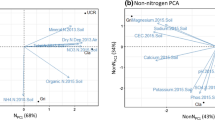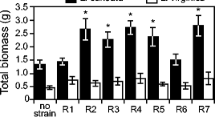Abstract
Background and Aims
Lespedeza cuneata is a non-native invasive legume that alters the soil bacterial community, associates promiscuously with rhizobia, and benefits more from rhizobial interactions compared to coexisting native Lespedeza in North America. We tested the hypothesis that native congeners differ in their nodule bacteria associations compared to L. cuneata.
Methods
Plots with high L. cuneata invasion, low L. cuneata invasion with native Lespedeza species present, and uninvaded plots where native Lespedeza species existed without L. cuneata were sampled. Nodules were collected from all Lespedeza species present, and Chamaecrista fasciculata, a common native annual legume. Bacterial DNA from nodules was isolated and sequenced.
Results
Nodule bacterial composition differed significantly between hosts. L. cuneata nodules contained high frequencies of rhizobial DNA and low bacterial diversity, while native Lespedeza nodules contained lower rhizobial frequencies and higher non-rhizobial bacterial diversity. Specific non-rhizobial bacterial groups exhibited strong associations with native legumes and uninvaded sites.
Conclusions
Significant differences exist in the nodule bacterial composition between native legumes and an introduced congener. The mechanism(s) and ecological importance of these differences remain unknown. These differences in bacterial associations could influence not only the competitive ability of the invader, but recovery of invaded sites as well.



Similar content being viewed by others
References
Annapurna K, Ramadoss D, Bose P, VithalKumar L (2013) In situ localization of Paenibacillus polymyxa HKA-15 in roots and root nodules of soybean (Glycine max. L.). Plant Soil 373:641–648
Aserse AA, Räsänen LA, Aseffa F, Hailemariam A, Lindström K (2013) Diversity and sporadic symbionts and nonsymbiotic endophytic bacteria isolated from nodules of woody, shrub, and food legumes in Ethiopia. Appl Microbiol Biot 97:10117–10134
Bai Y, D’Aoust F, Smith DL, Driscoll BT (2002) Isolation of plant-growth-promoting Bacillus strains from soybean root nodules. Can J Microbiol 48:230–238
Bai Y, Zhou X, Smith DL (2003) Enhanced soybean plant growth resulting from coinoculation of Bacillus strains with Bradyrhizobium japonicum. Crop Sci 43:1774–1781
Baldwin JG, Barker KR, Nelson LA (1979) Effect of Meloidogyne incognita on nitrogen fixation in soybean. J Nematol 11:156–161
Boukhatem AF, Domergue O, Bekki A, Merabet C, Sekkour S, Bouazza F, Duponnois R, de Lajudie P, Galiana A (2012) Symbiotic characterization and diversity of rhizobia associated with native and introduced acacias in arid and semi-arid regions of Algeria. FEMS Microbiol Ecol 80:534–547
Burke JM, Miller JE, Mosjidis JA, Terrill TH (2012) Grazing sericea lespedeza for control of gastrointestinal nematodes in lambs. Vet Parasitol 186:507–512
Callaway RM, Bedmar EJ, Reinhart KO, Silvan CG, Klironomos J (2011) Effects of soil biota from different ranges on Robinia invasion: acquiring mutualists and escaping pathogens. Ecology 92:1027–1035
Callaway RM, Thelen GC, Rodriguez A, Holben WE (2004) Soil biota and exotic plant invasion. Nature 427:731–733
Dudeja SS, Giri R, Saini R, Suneja-Madan P, Kothe E (2012) Interaction of endophytic microbes with legumes. J Basic Microb 52:248–260
Erdman LW (1950) The effectivity of different strains of Rhizobium on annual and perennial lespedezas. Soil Sci Soc Am Pro 15:173–176
Gu CT, Wang ET, Sui XH, Chen WF, Chen WX (2007) Diversity and geographical distribution of rhizobia associated with Lespedeza spp. in temperate and subtropical regions of China. Arch Microbiol 188:355–365
Horiuchi J, Prithiviraj B, Bais HP, Kimball BA, Vivanco JM (2005) Soil nematodes mediate positive interactions between legume plants and rhizobium bacteria. Planta 222:848–857
Hu L, Busby RR, Gebhart DL, Yannarell AC (2014) Invasive Lespedeza cuneata and native Lespedeza virginica experience asymmetrical benefits from rhizobial symbionts. Plant Soil 384:315–325
Huber T, Faulkner G, Hugenholtz P (2004) Bellerophon: a program to detect chimeric sequences in multiple sequence alignments. Bioinformatics 20:2317–2319
Hung PQ, Kumar SM, Govindsamy V, Annapurna K (2007) Isolation and characterization of endophytic bacteria from wild and cultivated soybean varieties. Biol Fert Soils 44:155–162
Hungria M, Nogueira MA, Araujo RS (2013) Co-inoculation of soybeans and common beans with rhizobia and azospirilla: strategies to improve sustainability. Biol Fert Soils 49:791–801
Ibáñez F, Angelini J, Taurian T, Tonelli ML, Fabra A (2009) Endophytic occupation of peanut root nodules by opportunistic Gammaproteobacteria. Syst Appl Microbiol 32:49–55
Ibewiro B, Sanginga N, Vanlauwe B, Merckx R (2000) Influence of phytoparasitic nematodes on symbiotic N2 fixation in tropical herbaceous legume cover crops. Biol Fert Soils 31:254–260
Kardol P, Cregger MA, Campany CE, Classen AT (2010) Soil ecosystem functioning under climate change: plant species and community effects. Ecology 91:767–781
Keane RM, Crawley MJ (2002) Exotic plant invasions and the enemy release hypothesis. Trends Ecol Evol 17:164–170
Kommuru DS, Barker T, Desai S, Burke JM, Ramsay A, Mueller-Harvey I, Miller JE, Mosjidis JS, Kamisetti N, Terrill TH (2014) Use of pelleted sericea lespedeza (Lespedeza cuneata) for natural control of coccidian and gastrointestinal nematodes in weaned goats. Vet Parasitol 204:191–198
Kumar V, Pathak CV, Dudeja SS, Saini R, Giri R, Narula S, Anand RC (2013) Legume nodule endophytes more diverse than endophytes from roots of legumes or non legumes in soils of Haryana, India. J Microbiol Biotechnol Res 3:83–92
Lei X, Wang ET, Chen WF, Sui XH, Chen WX (2008) Diverse bacteria isolated from root nodules of wild Vicia species grown in temperate region of China. Arch Microbiol 190:657–671
Leyns F, De Cleene M, Swings JG, De Ley J (1984) The host range of the genus Xanthomonas. Bot Rev 50:308–356
Mishra PK, Mishra S, Selvakumar G, Kundu S, Gupta HS (2009) Enhanced soybean (Glycine max L.) plant growth and nodulation by Bradyrhizobium japonicum-SB1 in presence of Bacillus thuringiensis-KR1. Acta Agric Scand Sect B Soil Plant Sci 59:189–196
Naisbitt T, James EK, Sprent JL (1992) The evolutionary significance of the legume genus Chamaechrista, as determined by nodule structure. New Phytol 122:487–492
Palaniappan P, Chauhan PS, Saravanan VS, Anandham R, Sa T (2010) Isolation and characterization of plant growth promoting endophytic bacterial isolates from root nodule of Lespedeza sp. Biol Fert Soils 46:807–816
Pandya M, Kumar GN, Rajkumar S (2013) Invasion of rhizobial infection thread by non-rhizobia for colonization of Vigna radiata root nodules. FEMS Microbiol Lett 348:58–65
Parker MA (2001) Mutualism as a constraint on invasion success for legumes and rhizobia. Divers Distrib 7:125–136
Parker MA, Malek W, Parker IM (2006) Growth of an invasive legume is symbiont limited in newly occupied habitats. Divers Distrib 12:563–571
Parker MA, Wurtz AK, Paynter Q (2007) Nodule symbiosis of invasive Mimosa pigra in Australia and in ancestral habitats: a comparative analysis. Biol Invasions 9:127–138
Pérez-Fernández MA, Lamont BB (2003) Nodulation and performance of exotic and native legumes in Australian soils. Aust J Bot 51:543–553
Peterson AT, Papes M, Kluze DA (2003) Predicting the potential invasive distributions of four alien plant species in North America. Weed Sci 51:863–868
van der Putten WH, Klironomos JN, Wardle DA (2007) Microbial ecology of biological invasions. ISME J 1:28–37
Reinhart KO, Callaway RM (2006) Soil biota and invasive plants. New Phytol 170:445–457
Richardson DM, Allsopp N, D’Antonio CM, Milton SJ, Rejmánek M (2000) Plant invasions- the role of mutualisms. Biol Rev 75:65–93
Rodríguez-Echeverría S, Crisóstomo JA, Nabais C, Freitas H (2009) Belowground mutualists and the invasive ability of Acacia longifolia in coastal dunes of Portugal. Biol Invasions 11:651–661
Ródriguez-Echeverría S, Fajardo S, Ruiz-Díez B, Fernández-Pascual M (2012) Differential effectiveness of novel and old legume-rhizobia mutualisms: implications for invasion by exotic legumes. Oecologia 170:253–261
Selvakumar G, Kundu S, Gupta AD, Shouche YS, Gupta HS (2008) Isolation and characterization of nonrhizobial plant growth promoting bacteria from nodules of kudzu (Pueraria thunbergiana) and their effect on wheat seedling growth. Curr Microbiol 56:134–139
Selvakumar G, Panneerselvam P, Ganeshamurthy AN (2013) Legume root nodule associated bacteria. In: Aurora NK (ed) Plant microbe symbiosis: fundamentals and advances. Springer, New Delhi, pp. 215–232
Sprent JI (2001) Nodulation in legumes. Royal Botanic Gardens, London
Sturz AV, Christie BR, Matheson BG, Nowak J (1997) Biodiversity of endophytic bacteria which colonize red clover nodules, roots, stems and foliage and their influence on host growth. Biol Fert Soils 25:13–19
Talbot G, Topp E, Palin MF, Massé DI (2008) Evaluation of molecular methods used for establishing the interactions and functions of microorganisms in anaerobic bioreactors. Water Res 42:513–537
Tang J, Bromfield ESP, Rodrigue N, Cloutier S, Tambong JT (2012) Microevolution of symbiotic Bradyrhizobium populations associated with soybeans in east North America. Ecol Evol 2:2943–2961
Tariq M, Hameed S, Yasmeen T, Ali A (2012) Non-rhizobial bacteria for improved nodulation and grain yield of mung bean [Vigna radiata (L.) Wilczek]. Afr J Biotechn 11:15012–15019
Tariq M, Hameed S, Yasmeen T, Zahid M, Zafar M (2014) Molecular characterization and identification of plant growth promoting endophytic bacteria isolated from the root nodules of pea (Pisum sativum L.). World J Microb Biot 30:719–725
Taurian T, Ibanéz F, Angelini J, Tonelli ML, Fabra A (2012) Endophytic bacteria and their role in legumes growth promotion. In: Maheshwari DK (ed) Bacteria in agrobiology: plant probiotics. Springer-Verlag, Berlin, pp. 141–168
Trujillo ME, Alonso-Vega P, Rodríguez R, Carro L, Cerda E, Alonso P, Martínez-Molina E (2010) The genus Micromonospora is widespread in legume root nodules: the example of Lupinus angustifolius. ISME J 4:1265–1281
Tye DRC, Drake DC (2012) An exotic Australian Acacia fixes more N than a coexisting indigenous Acacia in South African riparian zone. Plant Ecol 213:251–257
Velázquez E, Martínez-Hidalgo P, Carro L, Alonso P, Peix Á, Trujillo M, Martínez-Molina E (2014) Nodular endophytes: an untapped diversity. In: González MBR, Gonzalez-López J (eds) Beneficial plant-microbial interactions: ecology and applications. CRC Press, Boca Raton, pp. 215–236
Wang Q, Garrity GM, Tiedje JM, Cole JR (2007) Naïve Bayesian classifier for rapid assignment of rRNA sequences into the new bacterial taxonomy. Appl Microbiol Biot 73:5261–5267
Wolfe BE, Klironomos JN (2005) Breaking new ground: soil communities and exotic plant invasion. Bioscience 55:477–487
Yannarell AC, Busby RR, Denight ML, Gebhart DL, Taylor SJ (2011) Soil bacteria and fungi respond on different spatial scales to invasion by the legume Lespedeza cuneata. Front Microbiol 2:127. doi:10.3389/fmicb.2011.00127
Acknowledgments
This research was funded by the United States Army A896 Direct Funded Research Program.
Author information
Authors and Affiliations
Corresponding author
Additional information
Responsible Editor: Katharina Pawlowski.
Electronic supplementary material
Table S1
(DOCX 44 kb)
Rights and permissions
About this article
Cite this article
Busby, R.R., Rodriguez, G., Gebhart, D.L. et al. Native Lespedeza species harbor greater non-rhizobial bacterial diversity in root nodules compared to the coexisting invader, L. cuneata . Plant Soil 401, 427–436 (2016). https://doi.org/10.1007/s11104-015-2763-3
Received:
Accepted:
Published:
Issue Date:
DOI: https://doi.org/10.1007/s11104-015-2763-3




